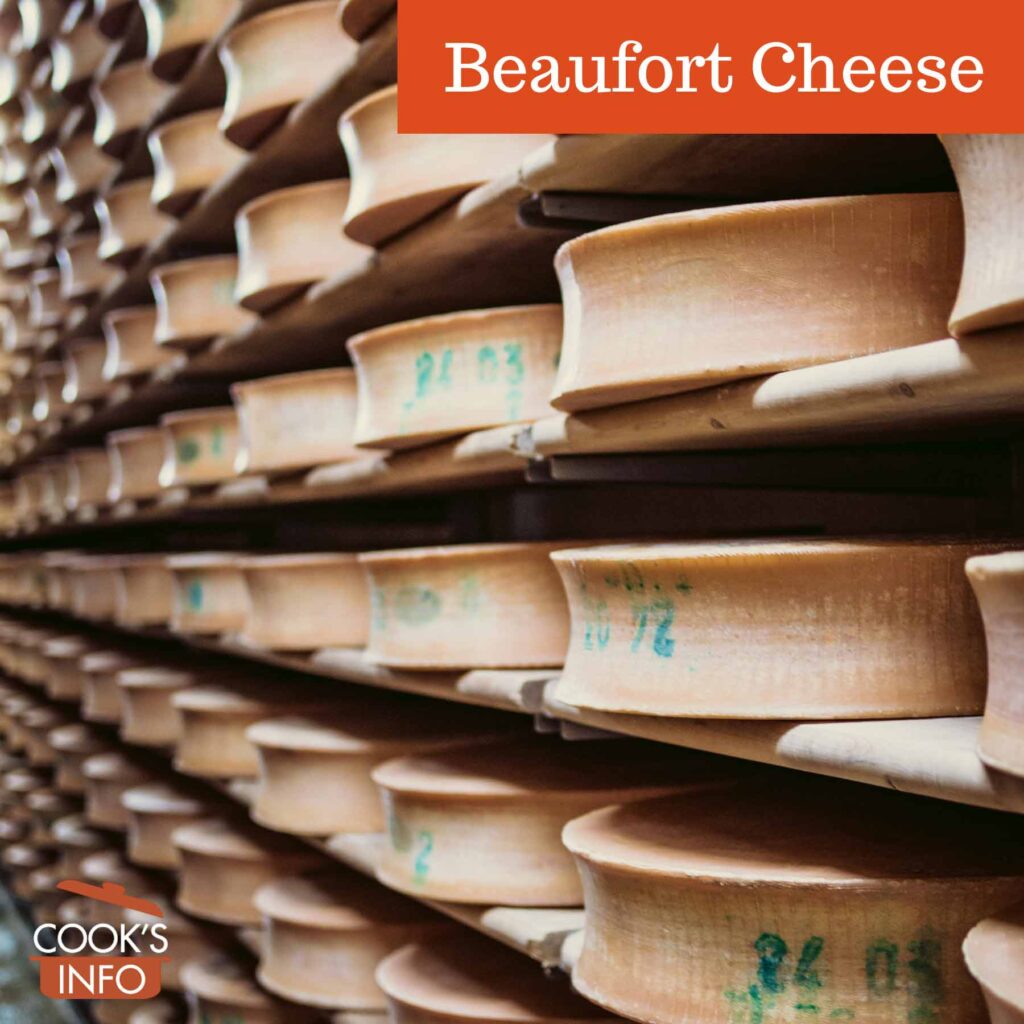Beaufort cheese is a semi-firm, smooth French cheese made in the Beaufort “commune” (township) of the Savoie region of France along the Alps.
Beaufort is similar to Comté, Gruyère and Emmenthal cheeses, but with no holes in it. There is a farmhouse version of Beaufort, and a version made in dairies.
The cheese is made year round. The summer version of Beaufort cheese is sometimes referred to as Beaufort d’été; the winter version is sometimes referred to as Beaufort d’hiver. Winter Beaufort cheeses are almost white; summer ones are pale yellow.
The farmhouse version is made up on small farms in the alps; it is called Beaufort d’alpage.
Production
It takes 10 kg (22 pounds) of milk to make 1 kg (2.2 pounds) of Beaufort produced.
The milk used for the cheese is whole raw milk from the Tarine or Abondance breeds of cows. In winter the cows are not fed any fermented fodder or silage (a measure which is presumed to reduce Listeria risk.)
The cows are milked twice a day. The milk from the morning’s milking is combined with milk from the previous evening. The milk is put in a large copper pot, brought to 33 C (91 F), and calves’ rennet added. The milk is allowed to curdle, then the curd is broken up into extremely small pieces, almost the size of rice, to help whey escape. The drained whey is then heated to 53 – 54C (127 to 128 F), and stirred constantly to cook the curd. More whey comes off during this process.
The whey is used to make Sérac cheese.
The curd is then put in a cheesecloth and then into round moulds made of wood, and pressed with a weight on it. Over the next 20 hours, the cheese is turned and has its cloth changed several times, and the weight put back on top. The cheese then sits for 1 day, then is placed in brine for 24 hours to develop a rind.
The cheese is aged for 5 to 12 months at 10 to 15 C (50 – 60 F). Twice a week during this time, it is turned and rubbed with salt. The rind turns brownish-red during the aging. Extra-old versions are aged 18 months.
A finished wheel of Beaufort cheese weighs anywhere from 20 to 70 kg (45 to 155 pounds), and can be 35 to 75 cm (14 to 30 inches) wide by 11 to 16 cm (4 to 6 inches) tall. The edges of the wheels are concave.
72.5 % of Beaufort cheese is produced by seven cooperatives (as of 2002) from milk produced by 700 different farmers.
The making of Beaufort cheese is regulated by the Syndicat de Défense du Beaufort and the Union des Producteurs de Beaufort. Per every 1,000 litres of milk made into Beaufort cheese, the cheesemaker pays dues of 18.5 € to the union and the syndicate.
Cooking Tips
Beaufort cheese melts well
Substitutes
Emmenthal, Gruyère, Swiss cheese
Nutrition
Beaufort cheese has a minimum 48% fat content.
History Notes
A push to really promote Beaufort cheese started in the 1950s. Large amounts of pasture land had been flooded by the opening of a hydro-electric dam. Town leaders saw that the old milk and cheese industry, producing generic milk and a relatively unknown cheese, couldn’t sustain the town. They invested in improving the quality of what they produced, promoted it, and managed to increase both the output and the quality, so that milk from cows in Beaufort now commands a 25% premium over many other milks.
They also introduced mobile milking machines, which allows the milk to get back to the cheese factories more quickly.
Beaufort cheese received its AOC on 4 April 1968 (the AOC was modified on 29 December 1986 to enlarge the acceptable production area.)
Language Notes
Beaufort cheese is named after the market town of Beaufort near Albertville, France.




